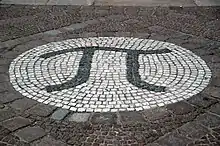π
See also: Π [U+03A0 GREEK CAPITAL LETTER PI], ∏ [U+220F N-ARY PRODUCT], ㄇ [U+3107 BOPOMOFO LETTER M], ㄫ [U+312B BOPOMOFO LETTER NG], 丌 [U+4E0C CJK UNIFIED IDEOGRAPH-4E0C], 兀 [U+5140 CJK UNIFIED IDEOGRAPH-5140], ㅠ [U+3160 HANGUL LETTER YU], and Appendix:Variations of "p"
 | ||||||||
| ||||||||
| ||||||||
Translingual

This mosaic is outside the mathematics building at the Technische Universität Berlin.


When a circle's radius is 1 unit, its circumference is 2π units.
Symbol
π
- (mathematics) Pi, an irrational constant representing the ratio of the circumference of a circle to its diameter; approximately 3.14159265.
- (particle physics) pion, pi meson
- (mathematics) homotopy group
- (mathematics) prime-counting function
- (linguistics, rare) A voiceless labiodental plosive (p̪).
Ancient Greek
Letter
π • (p) (lowercase, uppercase Π)
- Lower-case pi (πεῖ), the 16th letter of the ancient Greek alphabet. It represented the voiceless unaspirated bilabial plosive /p/. It is preceded by ο and followed by ρ.
Greek
Letter
π • (p) (lowercase, uppercase Π)
- The lower case letter pi (πι), the 16th letter of the modern Greek alphabet.
This article is issued from Wiktionary. The text is licensed under Creative Commons - Attribution - Sharealike. Additional terms may apply for the media files.